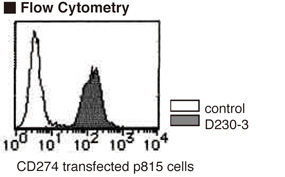This site is for customers in Asia.
Customers in China & other regions, please go to Global page.
HOME >
Product search results > Code No. D230-3
Anti-CD274 (PD-L1) (Human) mAb
Availability (in Japan)
10 or more
(In Japan at 00:05,
Apr 18, 2024 in JST)
Size
100 µL (1 mg/mL)
| Data | |||||
|---|---|---|---|---|---|
| Clonality | Monoclonal | Clone | 27A2 | ||
| Isotype (Immunized Animal) | Mouse IgG2b | ||||
| Applications | |||||
| Immunogen (Antigen) | Recombinant Human PD-L1 extracellular domain | ||||
| Reactivity [Gene ID] | Human[29126] |
||||
| Storage buffer | 1 mg/mL in PBS/50% glycerol, pH 7.2 | ||||
| Storage temp. | -20°C | Conjugate | Unlabeled | Manufacturer | MBL |
| Alternative names | B7H1 | ||||
| Background | Programmed death ligand 1 (PD-L1, also known as CD274/B7-H1), a member of B7 family was identified by searching for molecules that share homology with the immunogloblin V and C domains of B7-1 and B7-2 among the human cDNA expressed sequence tags in the National Center for Biotechnology Information database. PD-L1 is a ligand for programmed death 1 (PD-1) which belongs to the CD28/CTLA4 subfamily. Although <em>in vitro</em> study indicated that the cross-linking of PD-1 by PD-L1 leads to down-regulation of T-cell responses, some studies have shown that T cells stimulated with low levels of anti-CD3 and immobilized PD-L1-Ig were activated, proliferation and production of IFN-γ GM-CSF and IL-10 from the T cells were enhanced. The role of PD-L1 is now debatable. | ||||
| Related products | D230-5 Anti-CD274 (PD-L1) (Human) mAb-PE D092-3M2 Anti-CD274 (PD-L1) (Human) mAb (Functional Grade) D133-3M2 Anti-CD279 (PD-1) (Human) mAb (Functional Grade) D092-3 Anti-CD274 (PD-L1) (Human) mAb D132-3 Anti-CD279 (PD-1) (Human) mAb D132-4 Anti-CD279 (PD-1) (Human) mAb-FITC D132-5 Anti-CD279 (PD-1) (Human) mAb-PE D133-5 Anti-CD279 (PD-1) (Human) mAb-PE |
||||
| Citations |
Immunohistochemistry
|
||||
| Product category |
|
||||
- The availability is based on the information in Japan at 00:05, Apr 18, 2024 in JST.
- The special price is shown in red color.
- Please note that products cannot be ordered from this website. To purchase the items listed in this website, please contact us or local distributers.
- Abbreviations for applications:
WB: Western Blotting, IH: Immunohistochemistry, IC: Immunocytochemistry, IP: Immunoprecipitation
FCM: Flow Cytometry, NT: Neutralization, IF: Immunofluorescence, RIP: RNP Immunoprecipitation
ChIP: Chromatin Immunoprecipitation, CoIP: Co-Immunoprecipitation - For applications and reactivity:
*: The use is reported in a research article (Not tested by MBL). Please check the data sheet for detailed information.
**: The use is reported from the licenser (Under evaluation or not tested by MBL).
- For storage temparature: RT: room temparature
- Please note that products in this website might be changed or discontinued without notification in advance for quality improvement.









 Citations
Citations Data Sheet
Data Sheet


